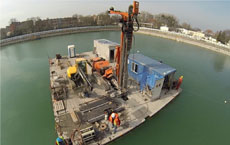| TITAN POLSKA Wins the ISM Third World Cup of Micropiles | |
September 25, 2019, Eighty Four PA: TITAN POLSKA, representing Europe, was selected as the winner of the Third World Cup of Micropiles by the delegates of the 14th International Workshop for Micropiles, hosted by the International Society for Micropiles (ISM) August 21-24, 2019, in Sofitel Broadbeach, Gold Coast, Queensland, Australia. TITAN POLSKA was selected for its project, the Museum of the Second World War in Gdańsk, Poland. Following is an abstract of the paper presented by Natalia Maca of TITAN Polska. Construction of the museum, completed in 2017, was one the most interesting and difficult projects, not only because of structural challenges, but also logistical and executive ones. One of the world biggest historical museums is located on the 1700 m2 lot touching the Radunia Canal to the west, while its south side faces the Motława River. The exhibition space is located in the 6 underground storeys, and the only above-ground part is the 40 m tall leaning tower. The concept required creating the excavation on the whole area of the lot with depth up to 18 m. As level of groundwater reached up to 2 m below the ground level, the works on foundation and securing the trench were complex and required the execution mostly underwater. In this situation, the first stage of construction works was the execution of the dry pit enabling the commencement of basic works related to the erection of the facility. This stage included the construction of the anchored diaphragm walls, earthworks (while the trench was naturally filled with water), concreting the cork, sealing and finally pumping out water. Since the self-weight of the openwork structure of the building proved insufficient to balance the buoyancy force, it was necessary to use the micropiles to anchor the cork and the foundation slab against buoyancy. The project assumed using 914 micropiles working in two phases: the temporary, not exceeded 2 years in which the tension load of a single micropile was 2080kN and the permanent (after the completion of all construction works) with the load reduced to 1690kN and the lifespan 100 years. The conditions for micropile work were extremely complex. Access to the front of the works was possible only from floating vessels, so the entire installation process (drilling and injection) could be carried out from pontoons, in the assistance of diver teams in the condition of very limited visibility underwater. This entailed also the need to install micropiles with the so-called dead passage through 16 m of water. The tight schedule demanded high efficiency of the installation with very good quality and precision of the work at the same time. Also the issue of anchoring the micropile head in concrete cork (still underwater) had to be solved. The TITAN self-drilling micropiles system, as meeting these requirements, was engaged. Micropiles of type 103/51 with 220 mm diameter drill bit were selected. The working length (restraint in the ground) has been calculated as 22 m. Taking into account the length of dead passage the working column of the micropile reached 40 m. Before commencing the main phase of the works, the static loads on preliminary micropiles were performed: the load capacity of 3000kN was achieved with the satisfactory characteristics of the work. The works were driven from the water surface with the entire construction facilities and drilling rig located on floating platforms. In order to ensure proper efficiency, a special procedure was developed for the installation of micropiles, with the use of a connector developed especially for this task, the so-called shell joint. It is a kind of split connector, which made the divers to easily unfasten the joint in order to release the two hollow bars fastened with it. After the release, dead passage column could be used as the beginning of the working column of another micropile (without dismantle) after the diver screwed the drilling bit on the last hollow bar remaining in the water. In the next step, the diver formed the head on previously made micropiles; a special type was developed in a form of a circular plate with a diameter of 480 mm equipped with a threaded sleeve and handles, which allowed the divers to stabilize the resistance plate in the appropriate position. Thanks to these sublime (though relatively simple) technical solutions and excellent work organisation, a very high capacity of 100-120 m of installed micropiles per day per work team has been achieved in these unusual conditions. A total of nearly 22 000 m of micropiles were built in the period from January to early April 2014. The diving crews, in addition to installation activities, also carried out inspection process, helping to control the quality of works. Finally, the underwater acceptance testing were performed, which also is not a routine activity. A supporting structure for the hydraulic jack was developed in the form of a steel frame based on four micro piles around the central micropile to be tested. Individual parts of the structure were lowered to the bottom and then assembled and levelled by divers. A through-hole hydraulic jack supplied from the surface and a measuring set of strain gauges were used for the test. Results from digital sensors were correlated with precise geodesy. The tested micropile was extended with the column of hollow bars above the water surface, so an optical measuring point could be mounted. On both micropiles the required test load of over 2300 kN was achieved, with a displacement not exceeding 25 mm. Successfully completed test loads paved the way to the last element of this stage of work - underwater concrete of the cork, after which it was already possible to pump out the water and carry out further work under standard conditions. The scale of the task and its complexity were exceptional and the time pressure intensified the level of difficulty. The project required an individual approach, the use of unique technical solutions and close cooperation of the process participants. Once again, the technology of the self-drilling micropiles, supported by expert know-how, proved its effectiveness and allowed it to succeed. About ISMThe International Society for Micropiles (ISM) is a consortium of international representatives involved in the design, construction, research/development and instruction/promotion of micropile technology. ISM provides an international forum for debate, advice, problem-solving and support to micropile specialists and nonspecialists throughout the world. Members of the Society can actively seek advice and experience from other members within this international group. ISM aims to be respected internationally as the preeminent center of knowledge for the development, advancement and promotion of micropile technology. |
 Installation of micropiles
 The Museum today
|
| ### |

